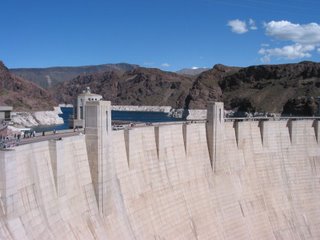In observing energy usage patterns, we have learned that the more energy efficient we humans become, the greater our demand for energy. An example of this is mankind's improvement in various battery technologies and microprocessors. Batteries have become more capable of delivering power over longer periods of time...and microprocessors more capable of using less power during that period.....this is why I can walk around with a handheld computer that doubles as a cell phone with four hours of continuous usage (this is a form of becoming more efficient).
A couple of quick facts - There are currently 219 million cell phones in the US and the average cell phone uses about 9 kilowatt hours of electricity per year.
Several years ago I went to see the Hoover Dam. The stories of its construction, how it works, and what it does are a mind bender. So I started to wonder...How much power consumption does the country's population of cell phones consume as denominated in number of Hoover Dams required to power that population? Based on a couple of different approaches, I estimate that about 60% of Hoover Dam's power output is used to keep our cell phones up and running on a continuous basis. Interesting...
of its construction, how it works, and what it does are a mind bender. So I started to wonder...How much power consumption does the country's population of cell phones consume as denominated in number of Hoover Dams required to power that population? Based on a couple of different approaches, I estimate that about 60% of Hoover Dam's power output is used to keep our cell phones up and running on a continuous basis. Interesting...
The cost-to-complete Hoover Dam in 1936 was $165 million or $2.3 billion in today's dollars. Hold that thought. Now think about the different number of devices that have been introduced to us over the past several years that consume electricty. Here is a brief list of things you may have added to your home over the past three years: iPod, Internet-enabled Cellphone, DSL/Cable Modem, Wireless Networking Access Point, Tivo Box, iPod Basestation Jambox, Portable DVD Player, Some GPS device, Home Theater Accessories, XM Radio Receiver.
Lets just assume for a moment that each of these 10 devices had the same popularity and power consumption needs as the cell phone above. This assumption implies that we would require 6 Hoover Dam-power-generating-equivalents to keep these devices up and running. Last I checked, the number of Hoover Dams going up every year is not keeping pace with what my imagination tells me is the increased electrical demand of these little power-hungry rodents.
Now lets turn away from the consumer market and think about industry. The increased use of internet protocol as a networking scheme combined with improved computer chip design and software design is causing the number of commercial and industrial edge devices to go nuts. Five years from now we are going to be monitoring and connecting everything to and from everywhere. Your iPod is sort of an example of the first step toward this end - better networking technology, good software design, all on a tiny little thing that can plug into the network from anywhere.
If I go back to my analysis of Hoover Dam and the $2.3 billion (in 2005 dollars) cost-to-complete, I then estimate that it requires $6.50 of investment to create power generation infrastructure capable of powering one cell phone (yes...this is all a little loose). I then start multiplying this by the number of little devices that exist in my consumer life and I wonder who is going to put the money up to build the power generation capability to support my new high-tech electronic lifestyle. Then I realize.....ME. It is going to come in higher rates over a sustained period because the planning, permitting and labor required to build more power producing infrastructure is going to take years and years and will be chasing an ever increasing target.
Then it hits me. I have got to invest in things that make for more efficient use of power so I can lower my overall usage. I then realize that the more efficient I become using power (like those batteries and microprocessors referred to above), the more alternative uses I can find for power (like my iPod) and the more power I will demand pushing the prices back up. I can't stop shopping at Best Buy.
How do I get off of this ride?
